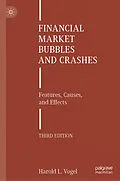Economists broadly define financial asset price bubbles as episodes in which prices rise with notable rapidity and depart from historically established asset valuation multiples and relationships. Financial economists have for decades attempted to study and interpret bubbles through the prisms of rational expectations, efficient markets, equilibrium, arbitrage, and capital asset pricing models, but they have not made much if any progress toward a consistent and reliable theory that explains how and why bubbles (and crashes) evolve and are defined, measured, and compared. This book develops a new and different approach that is based on the central notion that bubbles and crashes reflect urgent short-side rationing, which means that, as such extreme conditions unfold, considerations of quantities owned or not owned begin to displace considerations of price.
Harold (Hal) L. Vogel was the senior entertainment industry analyst at Merrill Lynch and inducted into Institutional Investor magazine's All-America Research Team Hall of Fame in 2011. Holder of a PhD in financial economics, he is also a chartered financial analyst (C.F.A.) and served as an adjunct professor at Columbia University's Graduate School of Business. His books include Entertainment Industry Economics: A Guide for Financial Analysis (10th edition 2020) and Travel Industry Economics: A Guide for Financial Analysis (4th edition 2021). He currently heads an independent investment and consulting firm in New York City.
Autorentext
Harold (Hal) L. Vogel was the senior entertainment industry analyst at Merrill Lynch and inducted into Institutional Investor magazine's All-America Research Team Hall of Fame in 2011. Holder of a PhD in financial economics, he is also a chartered financial analyst (C.F.A.) and served as an adjunct professor at Columbia University's Graduate School of Business. His books include Entertainment Industry Economics: A Guide for Financial Analysis (10th edition 2020) and Travel Industry Economics: A Guide for Financial Analysis (4th edition 2021). He currently heads an independent investment and consulting firm in New York City.
Inhalt
